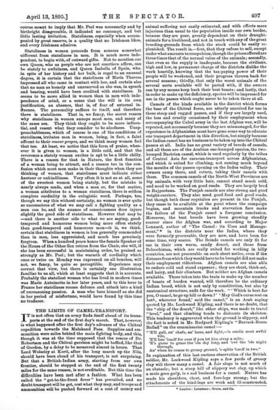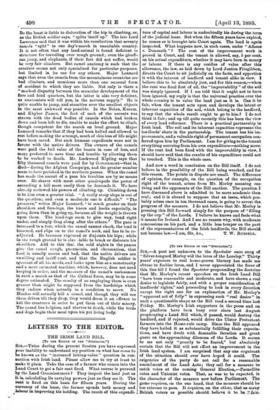THE LIMITS OF CAMEL-TRANSPORT.
TT is not often that an army finds itself ahead of its trans.
ports at the end of the first day's march. That, however, is what happened after the first day's advance of the Chitral expedition towards the Malakand Pass. Supplies and am- munition were miles behind the main fighting body, and this, though it was at the time supposed that the rescue of Dr. Robertson and the Chitral garrison might be baffled, like that of Gordon, by a delay to be measured almost in hours. That Lord Wolseley at Korti, after the long march up the Nile, should have been ahead of his transport, is not surprising. But that a British-Indian army, starting from our own frontier, should be stopped at the end of the first twenty miles for the same reason, is not ereditable. But this time the difficulties have been met after a fashion. What has been called the " get-to-the-front fever" has prevailed, and no doubt transport will be got, cost what they may, and troops an d ammunition will be pushed forward at a cost of money and animal suffering not easily estimated, and with effects more injurious than usual to the population inside our own border, because they are poor, greatly dependent on their draught- animals for a livelihood, and not in touch with any of the great breeding-grounds from which the stock could be easily re- plenished. The result is,—first, that they refuse to sell, except under what amounts to compulsion, though the prices offered are three times that of the normal value of the animals ; secondly, that even so the supply is inadequate, because the civilians, high and low, in permanent charge of the districts dislike the work heartily, knowing that the tax-paying power of their people will be weakened, and their progress thrown back for several seasons ; thirdly, that only the worst animals of the several sorts available will be parted with, if the owners can by any means keep back their best beasts ; and lastly, that in order to make up the deficiency, species will be impressed for use in the passes which ought never to be taken there at all.
Camels of the kinds available in the district which forms the base of the Chitral force, are utterly unsuited for use in these steep and rugged passes, and if they are largely used, the loss and cruelty occasioned by their employment when accompanying the Cabul army in the last Afghan war, will be repeated, not necessarily because they are mismanaged, for the experience in Afghanistan must have gone some way to educate our transport department in this direction, but simply because the Indian camel has no business to be taken up into the Chitral passes at all. India has no great variety of breeds of camels, and all these are of the Arabian one-humped species, the two- humped Bactrian camel, which is used regularly by the tribes of Central Asia for caravan-transport across Afghanistan, and which is suited for climbing, not coming much beyond the mouths of the passes opening on the Indus valley. Their owners camp there, and return, taking their camels with them. The common camels of the North-West Provinces are big animals, with very little hair, cannot stand much cold, and need to be worked on good roads. They are largely bred in Rajpootana. The Punjab camels are also strong and good weight-carriers. They also need good food and good roads, but though both these requisites are present in the Punjab, they cease to be available at the point where the campaign begins, and mountain tracks and starvation fare make the failure of the Punjab camel a foregone conclusion. Moreover, the best breeds have been growing steadily scarcer since the Afghan war, and according to Major Lennard, author of " The Camel : its Uses and Manage- ment,"* in the districts near the Indus, where they were formerly procurable, they are now, and have been for some time, very scarce. The Scinde camels are only fit for use in their own warm, sandy desert, and those from Beloochistan, which are really suited for working in hilly countries, are not procurable on such short notice, even if the distance from which they would have to be brought did not make their employment ridiculous. Afghan camels are also able to endure cold and stand exposure ; they are short, thick-set, and hairy, and fair climbers. But neither are Afghan camels available. Those taken into the train to make up the number of beasts of burden wanted, will therefore be the ordinary Indian breed, which is not only by constitution, but also by anatomical structure, unfit for the work. " ' Which is best for you, 0 camel, to go up hill or down ? " May God's curse rest on both, wherever found,' said the camel," is an Arab saying quoted by Mr. Lockwood Kipling, and there is no doubt, that the " ship of the desert," like other ships, was made to travel "level," and that climbing tends to dislocate its skeleton. This tendency is aggravated when the ground is slippery, and the fact is noted in Mr. Rudyard Kipling's "Barrack-Room Ballad" on the commissariat camel :-
"'E'll gall, an' chafe, an' lame, and fight,—'e smells most awful vile,
'E'll lose 'isself for ever if you let him stray a mile ; 'E's game to graze the 'ole day long, and 'owl the 'ole night through,
An' when he comes to greasy ground, 'e splits 'isself in two."
In explanation of this last curious observation of the British soldier, Mr. Lockwood Kipling says a few yards of greasy clay will throw many a camel. A fair slope is not much of an obstacle; but a steep hill of slippery wet clay, up which a mule goes gaily, is a sad business for a camel. Nature has made his shoulders, chest, and fore-legs strong ; but the attachments of the hind-legs are weak and ill-constructed.
• London : Longman-. Green. and Co. So the beast is liable to dislocation of the hip in climbing, or, as the British soldier says, " splits 'isself up." The late Lord Lawrence said that it was within his recollection that seventy camels "split" in one day's march in unsuitable country. It is not often that any land-animal is found deficient iu structure for travelling over rough ground ; even the giraffe can jump, and elephants, if their feet did not suffer, would be very fair climbers. But camel anatomy is such that the creature seems not only specialised. for particular purposes, but limited in its use for any others. Major Lennard says that even the camels from the mountainous countries are bad climbers, and mentions more than one unusual form of accident to which they are liable. Not only is there a "marked disparity between the muscular development of the fore and hind quarters, but the latter is also very deficient, as anatomists will tell you, in the nervous supply." He is quite unable to jump, and stumbles over the smallest objects in the most awkward way possible. In the Bolan, Kuram. and Khyber Passes, the foot of each of the ascents was strewn with the dead bodies of camels which had broken down and been left to die, unable to make the effort to climb, though competent for the march on level ground. Major Lennard remarks that if they had been halted and allowed to rest before making the attempt, much of this loss of life might have been saved. But such humane expedients were not in favour with the native drivers. The owners of the camels were paid the full value of the beasts in case of lose, and many preferred to save time and trouble by allowing them to be worked to death. Mr. Lockwood Kipling says that fifty thousand camels were paid for by Government—that is, died— during the Afghan Campaign, and the greater number seem to have perished in the northern passes. When the camel has made the ascent of a pass his troubles are by no means over. He shares with most other quadrupeds the power of ascending a hill more easily than he descends it. We have already reviewed his powers of climbing up. Climbing down is to him even a greater trial. "A really steep slope is out of the question; and even a moderate one is difficult." " The pressure," writes Major Lennard, " is much greater on their shoulders and fore-legs, the knees and hocks especially, in going down than in going up, because all the weight is thrown upon them. The hind-legs seem to give way, bend right under, and simply drag along after the others." The pace is increased to a trot, which the camel cannot check, the load is loosened, and slips on to the camel's neck, and has to be re- adjusted. He becomes ruptured or disjoints his hips; while in the rough ground he is also .fable to break or dislocate his shoulders. Add to this that the cold nights in the passes give the camel cough, pneumonia, and rheumatism, that food is usually scarce and bad, that the native drivers are unwilling and inaiff-rent, and that the English soldier is iguorant of all his needs, and looks upon him as a monstrosity and a mere animated machine, which, however, does not need keeping in order, and the measure of the camel's uselessness in such a march as that of the Chitral force, may be in some degree estimated. The cruelty of so employing them is even greater than might be supposed from the hardships which they endure when actually in a condition to move. No Hiudoo will actually kill a camel, and though they will see them driven till they drop, they would deem it an offence to kill the creatures in order to put them out of their misery. The camel lies helpless, and starves to death, while the birds and dogs begin their meal upon his yet living body.



































 Previous page
Previous page